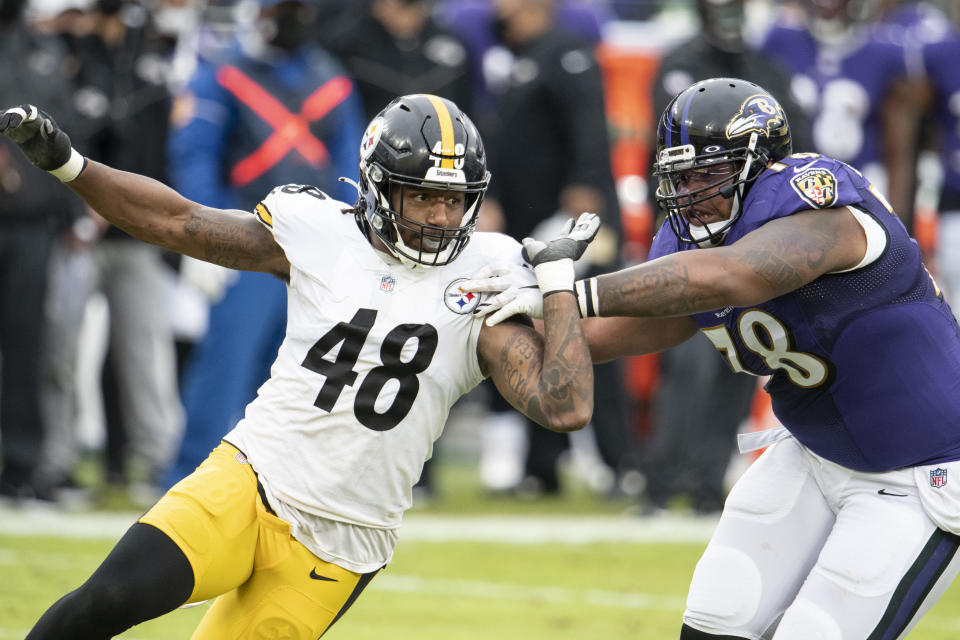Why the Chiefs may have hit the jackpot in the Orlando Brown trade

In Super Bowl LV, Chiefs left tackle Eric Fisher and right tackle Mitchell Schwartz were out due to injuries, and that’s a primary reason Patrick Mahomes was pressured on 31 of his 56 dropbacks. (Note: The Buccaneers’ outstanding defense was another). Soon after Kansas City’s 31-9 loss, the Chiefs released both Fisher and Schwartz to free up cap space for free-agency moves. Two of those moves were to sign former Patriots guard Joe Thuney to a five-year, $80 million contract, and to sign former Bears guard Kyle Long to a one-year, $1.5 million deal with up to $3.5 million available in incentives.
All good on the inside, but those moves didn’t cover edge protection, which had become the defending AFC champions’ most glaring need. On Friday, Kansas City went a very long way in solving one side of that particular issue when they traded their 2021 first-round pick (No. 31 overall), their 2021 third-round pick (No. 94), their 2021 fourth-round pick (No. 136), and a 2022 fifth-round pick to the Ravens in exchange for offensive tackle Orlando Brown Jr., Baltimore’s 2021 second-round pick (No. 58 overall), and a 2022 sixth-round pick.
Brown, who sees himself as a dominant left tackle (and wants to be a very highly-paid one to boot), switched from the right to the left side in Week 8 of the 2020 season after starting left tackle Ronnie Stanley was lost for the remainder of the season due to a broken ankle. Brown was known more as a right-side mauler, but he more than held his own on Lamar Jackson’s blind side, allowing no sacks, one quarterback hit, and 16 quarterback pressures on the left side from Week 8 through the Ravens’ divisional-round loss to the Bills.

(Tommy Gilligan-USA TODAY Sports)
Selected in the third round of the 2018 draft out of Oklahoma by the Ravens, Brown has allowed just six sacks in his NFL career, per Pro Football Focus, and none in the 840 left tackle snaps he’s taken out of 2,326 career snaps. The Ravens had a short-drop passing offense for the most part in 2020, but both Lamar Jackson and Patrick Mahomes obviously give their blockers extra tests with their second-reaction ability, which can throw them in the path of more (and potentially angrier) pass-rushers.
So, Brown established himself as an outstanding both-sides blocker in 2020. The question for the Chiefs now it, how do they go forward with their new acquisition? Brown is coming into the final year of his rookie deal — a deal that gives him a $3,384 million base salary and a presents a $3,600,430 cap hit in 2021. The Chiefs did not have a long-term deal with Brown at completion when they made the trade, so the obvious assumption is that they’ll get it done as things go along. They could always take a pay-as-you-go approach here, tag him in 2022, and see how it goes, or they could reduce the short-term cap liability next season with a longer-term deal.
Currently, the highest-paid left tackles in the NFL make an average of $18.39 million per year, and San Francisco’s Trent Williams tops out the guaranteed money scale with $45 million — the major part of the six-year, $138.06 million deal the 49ers gave Williams in March to make sure he sticks and stays in the Bay Area.
But the Chiefs are under no obligation to do so. They have Brown under club control in 2021 for a pittance compared to his value, and while they could ease the transition with a longer-term deal, they could also wait and see. Unlike the Texans, who traded two first-round picks and a second-round pick to the Dolphins for Laremy Tunsil in September, 2019 without a long-term deal in place, the Chiefs are not giving up so much capital that any option but a long-term deal would be a nuclear option. As it was, the Texans had to sign Tunsil to a three-year, $66 million deal with $40 million guaranteed that made him the highest-paid left tackle in the NFL at that time. Whether Tunsil was worth that much in a comparative market made no difference; the Texans had put themselves in an impossible position with their impulse buying in the first place.
The Chiefs, as is their tendency, were smarter about such things. They gave up the 31st overall pick and picked up the 58th overall pick, with a few more moving parts in the equation, and filled their most glaring need. If Brown proves to be everything he was and then some in 2020, it’s a great deal. Even if he doesn’t. the Chiefs didn’t give up too much in order to find out.

